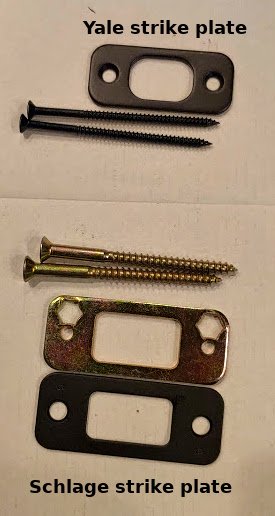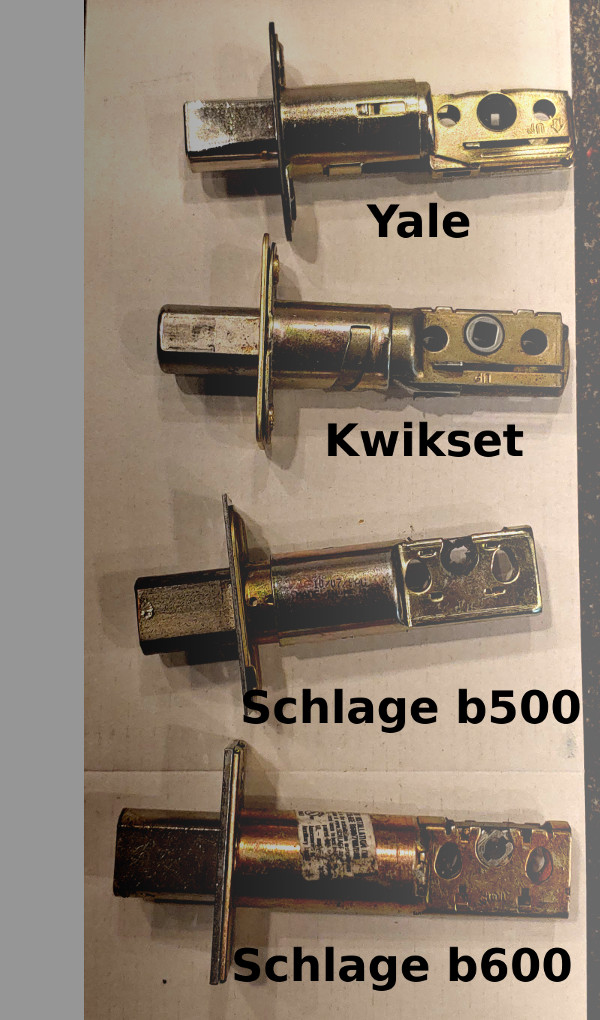There is a lot of information on the internet about comparisons between electronic deadbolts with regard to ease of programming, looks, and wireless features. I haven’t seen a lot of information about the actual physical security of these locks anywhere though. I am going to conduct a test of popular electronic deadbolts as soon as I find a building that will be torn down so that I can install these deadbolts and actually kick the doors in myself, but until then I thought a comparison between the bolts and strike plates would be in order.

I installed a couple of the Yale electronic deadbolts a few days ago and was struck by how small the strike plate is. Kwikset isn’t much better either. The strike plates are smaller than most manufacturer’s strike plates. The standard size I encounter most is 1.25×2.75″. This is the size that commercial doorframes are prepped for. Schlage makes them this size. When replacing larger strike plates these don’t fit the mortise. The smaller strike plate looks terrible in a wooden doorframe with wood exposed around the small strike. The small strike wouldn’t even be installable in a commercial metal door frame.

The screws that come with the Schlage strike come in two sizes. The really long thick screws and the really thick strike plate go under the thinner strike plate which is decorative. Two small screws hold the decorative strike plate over the more secure strikeplate.
The screws that come with the Yale strikeplate are long but much thinner. The screws that come with the Kwikset are even shorter. The Schlage electronic deadbolts which all come with this package of decorative strike and thicker more secure strike with long thick screws win hands down over the competition when it comes to strikes and screws.
Next comes the boltlatch; the bolt that, when extended, keeps the door secured. The Yale bolt seems a little on the thin and cheaply made side. I suspect this bolt will be the easiest to defeat when kicking a door in but this is just a hunch until I actually conduct a test with repeatability. The Kwikset boltlatch is fairly unimpressive but due to it being used on a lot of lower income properties subject to more crime I have seen the results of their being forced and they stand up to a surprising amount of abuse.

Schlage B500 boltlatches are quite resilient though they will be defeated if the gap between the door and frame is large and the door is kicked hard enough of course. The bolt itself is a larger piece of metal than the Yale and Kwikset bolts.
Schlage electronic locks don’t come with B600 series boltlatches but they are compatible with Schlage electronic locks, though the tailpiece on newer Schlage models have to be modified or replaced (more on that later). The B600 bolt is leagues ahead of the competition. If you want a secure electronic deadbolt you can’t do better than a Schlage Encode or Connect with a B600 bolt. The bolt is probably 50% thicker. If you feel it in your hand you will note it is better constructed when compared to the other two.
Another component to be considered is the lock cylinder itself. The Kwikset smartkey cylinder is admittedly very difficult to pick. There is a trick I won’t reveal here that makes many of these pretty easy to remove from the door and put back on without any visible damage. These lock cylinders are also fairly vulnerable to tryout keys. I think you only need 200 keys cut in specific half-depths to open all Kwikset smartkey locks. What it does have that is great is a sidebar and that makes it fairly hard to drill out.
The Yale has a regular Kwikset cylinder without any bells or whistles. It’s pretty trivial to pick these, though criminals don’t tend to pick residential locks around Seattle very often. The danger with the Yale and the Kwikset is that entry could be obtained without any obvious sign, making insurance difficult to collect if anything was stolen.
The Schlage has a fairly unexciting lock cylinder. It is a five pin lock cylinder with some security pins and some hardened steel inserts. It isn’t difficult to drill it out, much easier than the Kwikset if you want to know the truth. What sets it apart is that the lock cylinder that comes with Schlage electronic locks comes in a standard form factor called a 99 type key in knob cylinder. While not exactly standard, it means that with a little work the lock cylinder in these can be replaced with one from any manufacturer. This means that the Schlage electronic locks can be upgraded to a very secure cylinder that can’t be picked or drilled very easily at all. I have installed Medeco, Multilock, Primus, CX5 and Protec2 cylinders in these locks. The only thing necessary to get them to work right is to either replace the bolt with either a B500 or B600 bolt, or to grind the tailpiece of the cylinder so that it will work with the special bolt that comes with the lock.
So if you are concerned about somebody kicking your door in, remember these differences when you are shopping for one of these deadbolts. The reasons listed are why I recommend people buy Schlage electronic deadbolts.
